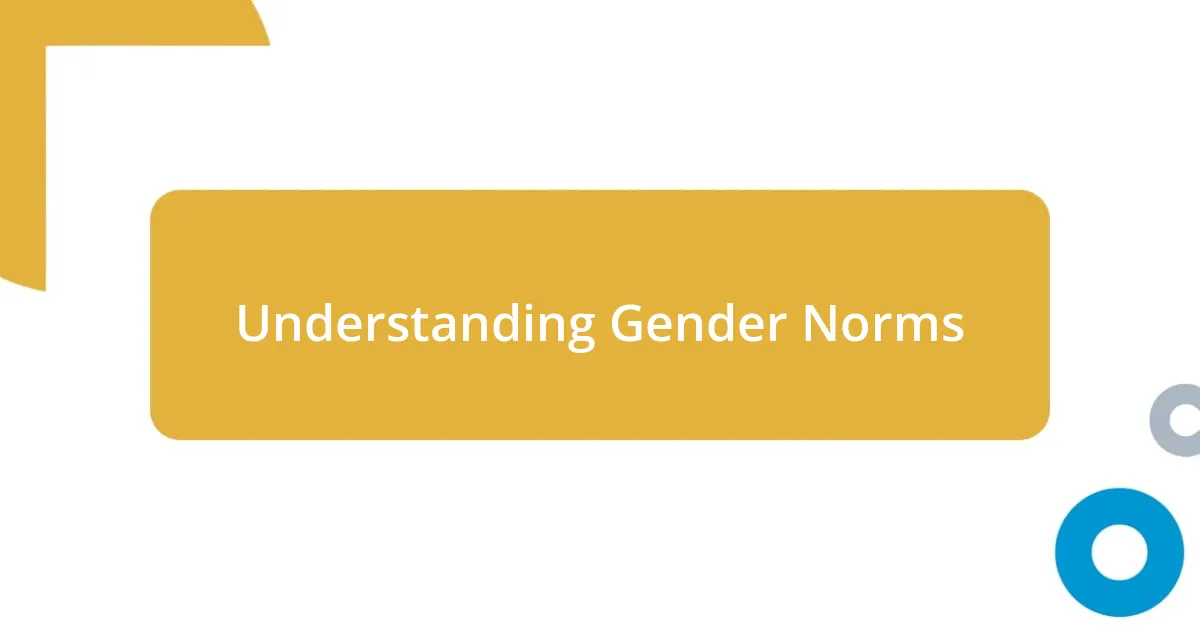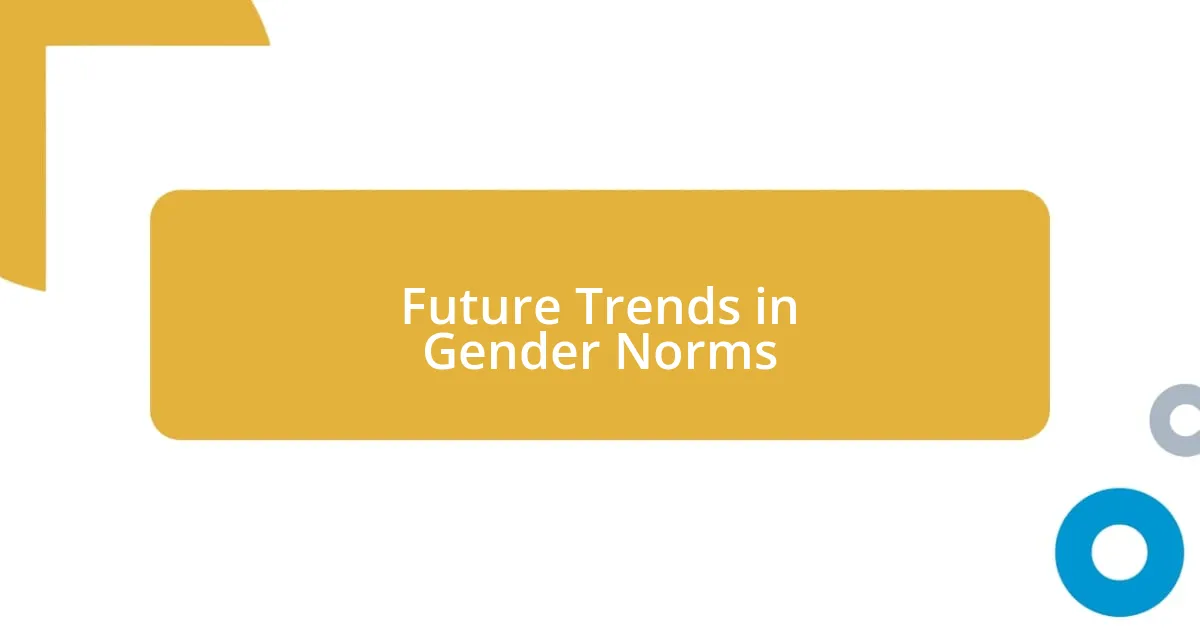Key takeaways:
- Gender norms are societal expectations that shape individual behaviors and self-perceptions, often leading to internal conflicts and pressures to conform.
- Historical developments, such as the industrial revolution and feminist movements, have gradually challenged and evolved traditional gender roles.
- Cultural variations in gender norms highlight both rigid expectations and a growing acceptance of fluid identities across different societies.
- Practical steps, including inclusive language and community engagement, are essential for redefining and changing entrenched gender norms.

Understanding Gender Norms
Gender norms are societal expectations about how individuals should behave based on their gender. I remember a friend in high school who loved playing football but often faced ridicule because it didn’t fit the traditional image of a girl. This made me question: Why do we confine people to these roles?
As I reflect on my own experiences, I can see how gender norms shape not just our actions but also our self-perception. For instance, there was a time when I hesitated to pursue a field in tech because I thought it was a ‘male-dominated’ space. This internal conflict led me to explore what I truly valued and pushed me to break free from those norms.
The pressure to conform can be suffocating. Have you ever felt that disconnect between your interests and societal expectations? I certainly have. It’s crucial to recognize that these norms are not fixed; they evolve as we challenge and redefine them in our daily lives. When people openly defy these standards, it can inspire others to do the same, creating a ripple effect of authenticity and freedom.

Historical Context of Gender Norms
Gender norms have deep historical roots that are often intertwined with cultural, religious, and economic factors. For instance, I remember studying how ancient societies assigned specific tasks based on gender—men were hunters and warriors, while women were gatherers and caregivers. This division, although practical in those times, laid the groundwork for rigid expectations that persist today.
- In the 18th century, Enlightenment thinkers began questioning gender roles, advocating for equal rights, yet many traditional norms remained entrenched.
- The industrial revolution further complicated these roles, as women began to enter the workforce, challenging the notion that their place was solely in the home.
- Fast forward to the mid-20th century, the feminist movements erupted, compelling society to rethink gender norms more drastically.
Reflecting on these changes, I often think about how my own grandmother worked tirelessly, balancing family duties and a job, defying the typical 1950s housewife mold. Her story highlights the importance of acknowledging the struggles and contributions of those who came before us, all while reminding me that evolving gender norms can pave the way for future generations to live more freely.

Gender Norms in Different Cultures
When it comes to gender norms, the variations across cultures are striking. I recall traveling to Japan, where the concept of “dansei no shakai” (men’s society) and “josei no shakai” (women’s society) often dictates behavior. It was fascinating to observe how these distinctions influenced daily life, from work roles to family dynamics. My experience had me questioning the impact these norms have on personal identity. How must it feel for someone who doesn’t fit neatly into these cultural boxes? It can be both liberating and confining, depending on the individual’s journey.
In contrast, in many Western cultures, I’ve noticed a growing acceptance of fluid gender identities, though challenges remain. I think of a friend from college who expressed their gender identity non-binarily and how refreshing it was to see such openness. This has empowered others I know to explore their true selves unapologetically. It’s heartening to think about how cultures can influence one another, pushing boundaries and allowing for more individual expression. However, I’ve also seen the resistance to these shifts, which makes me wonder: can we ever truly escape the shadows of entrenched norms?
To give you a clearer picture, take a look at the comparative table of gender norms in different cultures. It’s interesting to think how context shapes our perceptions and behaviors, isn’t it? It reminds me of just how rich and diverse human experience can be.
| Culture | Gender Norms |
|---|---|
| Japan | Strict distinctions in roles; expectations for men to be providers and women caregivers |
| United States | Growing acceptance of non-binary identities; an ongoing struggle for equality |
| India | Traditional norms that often dictate marriage and job roles; emerging movements challenge these norms |
| Sweden | Progressive notions promoting gender equality; shared parental leave and gender-neutral education |

Challenging Traditional Gender Norms
Challenging traditional gender norms often requires stepping out of our comfort zones. I remember a colleague who decided to take paternity leave, something that was traditionally seen as a mother’s domain in his workplace. His decision sparked conversations and even a bit of awkwardness among his peers, but it also encouraged others to rethink what it means to be a caretaker, regardless of gender. Isn’t it interesting how one person’s choice can challenge the status quo and inspire others?
In my community, I’ve seen a remarkable shift as men embrace roles traditionally assigned to women, like cooking and child-rearing. I was moved when a neighbor held a community cooking class for fathers, where they shared not only recipes but also stories of their own vulnerabilities and experiences. This initiative didn’t just promote cooking skills; it created a space for men to bond over breaking gender stereotypes. It makes me wonder: what if we all embraced those softer aspects of ourselves more openly?
On a personal note, I’ve grappled with my own perceptions of masculinity and femininity, particularly when my brother, a firefighter, started painting as a form of therapy. Initially, I questioned whether he would be judged for this passion, but what I observed was incredibly affirming. His courage to pursue art not only challenged his own beliefs but, surprising to me, also inspired friends who had long shelved their creative interests. Perhaps the challenge lies not just in the actions we take, but in the willingness to redefine our understanding of identity and passion—how can we cultivate more of that in our everyday lives?

Practical Steps to Change Norms
To change norms effectively, it starts with engagement at every level—personal, community, and institutional. I remember attending a local town hall where we discussed introducing gender-sensitive policies in schools. The energy in the room was palpable; parents shared their concerns about how language and behavior shape children’s perceptions of gender. It struck me how one conversation could ripple outwards, encouraging everyone to see the impact of small changes.
On a more personal level, I’ve committed to using inclusive language in my day-to-day conversations. There was a moment when a friend, who identifies as non-binary, expressed gratitude for being addressed without assumptions. This simple acknowledgment shifted our group dynamics to be more considerate and conscious. It makes me think: if just a few words can change perspectives, how many more can we adopt?
Through workshops and community initiatives, people can share tools and resources for navigating and challenging norms. I once facilitated a session where individuals discussed their experiences with gender stereotypes, and the catharsis in that room was breathtaking. I found myself pondering how powerful shared stories can be in dismantling barriers. If we can create spaces for these conversations, can we imagine just how much progress we could make toward redefining societal expectations?

Future Trends in Gender Norms
I see a dynamic shift on the horizon, where fluidity in gender roles becomes not just accepted but celebrated. I remember a recent conversation with a colleague about her son’s choice to wear nail polish to school. While some peers raised eyebrows, she shared how it sparked inspiring discussions about individuality rather than conformity. Isn’t it heartwarming to think that children might grow up feeling free to express themselves, regardless of societal pressures?
As we look forward, I anticipate an increase in media representation that breaks away from traditional stereotypes. I was struck by a documentary I recently watched that featured men who actively participate in typically “feminine” professions, such as nursing and teaching. Their stories were not only compelling but also uplifting, as they portrayed how fulfillment can come from roles one truly resonates with, regardless of gender. Could this be a catalyst for young people to follow suit without fear of judgment?
Moreover, technology will play a pivotal role in reshaping our conversations around gender. I recall a fascinating app designed to educate users about gender identity and expression, fostering understanding and respect. It’s amazing to think that, through a smartphone, individuals can explore such complex topics. Isn’t it exciting to imagine what future generations might believe about gender norms, shaped by both knowledge and empathy rather than outdated ideologies?














